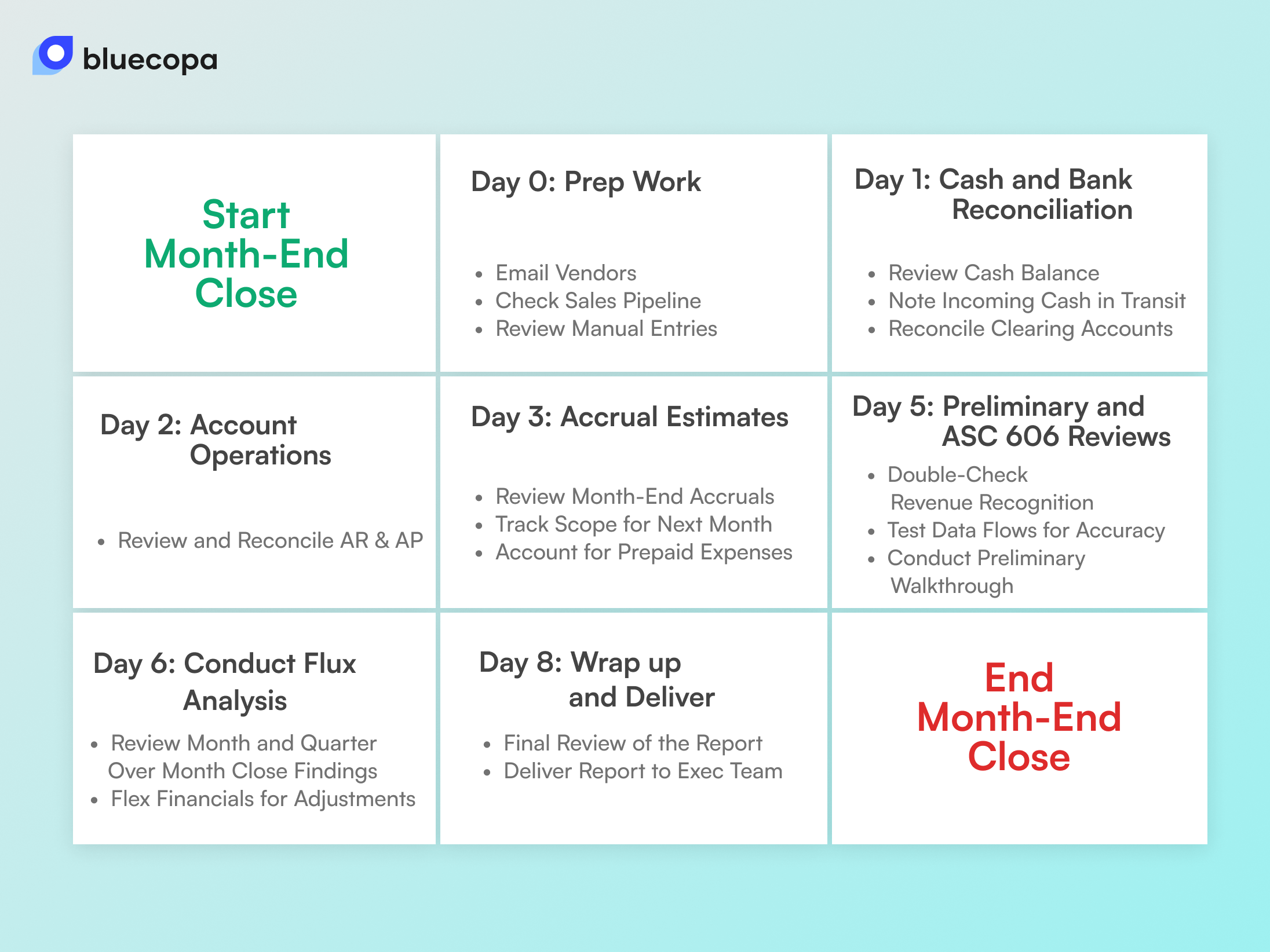So, every month, quarter, or year, what comes around is financial closing. Even though it looks simple at the outer angle, today’s distributed workforce makes it more mazy. Continuous searches for documents and surprising delays are common events with the month-end close process.
With financial closing, finance teams take a deeper look at the earnings and spending of the previous fiscal term. It furnishes an opportunity for them to analyze numbers, assess whether they are intact, and find growth areas.
But the sad part is finance teams get pressured to close the books faster. The stress levels peak and it in turn makes the process even more convoluted. Here’s a fix. We have compiled a standard month-end close process flowchart that you could adopt and find success.
In this blog post, we introduce you to the concept, the major steps involved, and some activities that could be automated. You also get a shareable month-end close checklist that helps you reduce the process from weeks to days.
Get on board and read away.
What is the month-end close process and its steps?
The month-end close process involves reconciling, adjusting, and finalizing financial records to produce accurate and insightful financial statements. This crucial monthly ritual typically involves several key steps.
Step 1: Preparation
The first step is to gather all the required financial documents, reports, and statements. This includes transaction records, bank statements, and any relevant supporting documentation.
Step 2: Reconciliation
Reconciliation is an important task due to the large number of financial transactions that occur throughout the month. It involves carefully comparing and reconciling balance sheets, income statements, and cash flow statements to identify and correct any discrepancies.
Step 3: Adjusting entries
To ensure financial accuracy, a company makes adjusting entries to account for accruals, deferrals, and necessary corrections. These entries accurately reflect the financial state of the business.
Step 4: Financial reporting
The month-end close process focuses on generating and reviewing financial statements, such as the balance sheet and income statement. These statements are crucial for decision-making, providing valuable insights into financial health.
Step 5: Closing entries
During this step, temporary accounts, such as revenue and expense accounts, are closed to prepare them for the next accounting period. This process ensures a fresh start for the upcoming financial cycle.
Step 6: Audit preparation
Modern finance teams prioritize transparency by utilizing the month-end close process to prepare for audits and ensure accurate documentation.
Why is it complicated and takes time?
The month-end close process is hard and time-consuming for various reasons, including—
Unrecognizable volume of transactions
Finance teams handle a substantial volume of financial transactions daily. Managing and reconciling these transactions requires significant time and attention to detail.
Reliance on multiple systems
Finance teams rely on a multitude of financial systems and software for different aspects of their operations. Integrating data from these disparate sources can be difficult, leading to delays and increased complexity.
Manual data entry
Manual data entry remains a common practice in many finance teams. This not only increases the risk of errors but also consumes valuable time that could be better utilized for strategic financial planning.
Reconciliation challenges
Reconciling accounts, particularly when dealing with interdepartmental transactions or multiple currencies, introduces inherent challenges. Resolving discrepancies and ensuring the accuracy of financial records demands scrutiny.
What can be automated in the month-end close process?
Automation can significantly streamline the month-end close process by handling routine and time-consuming tasks. It allows finance teams to focus on more strategic activities.
Here are five mundane tasks that can be automated:
#1 Data reconciliation
🏋 The challenge
Reconciling data from various sources can be a tedious and error-prone task. It often involves comparing large datasets and identifying discrepancies.
🏆 How does automation help?
Implementing automation tools can facilitate the automatic reconciliation of data. These tools can match transactions, identify discrepancies, and generate reconciliation reports, reducing the risk of errors and saving time.
#2 Journal entry generation
🏋 The challenge
Creating and posting journal entries for accruals, deferrals, and adjustments is a repetitive and time-consuming process that requires meticulous attention to detail.
🏆 How does automation help?
Automation platforms can be programmed to generate and post journal entries automatically based on predefined rules. This reduces the chances of human error and accelerates the overall process.
#3 Report generation
🏋 The challenge
Compiling financial reports involves collecting data from various sources, formatting it, and creating comprehensive reports. This process can be time-intensive, especially when dealing with large datasets.
🏆 How does automation help?
Automated reporting tools can pull data from different systems, generate predefined reports, and distribute them to relevant stakeholders. This ensures that financial reports are accurate, timely, and consistent.
#4 Account reconciliation
🏋 The challenge
Reconciling accounts involves comparing balances, identifying discrepancies, and resolving issues. This process is often performed manually, making it susceptible to errors and consuming time.
🏆 How does automation help?
Automation tools can reconcile accounts by systematically comparing ledger balances, bank statements, and other financial records. This not only speeds up the reconciliation process but also enhances accuracy.
#5 Audit trail management
🏋 The challenge
Maintaining a detailed audit trail for compliance and audit purposes requires meticulous documentation of every financial transaction and adjustment, which can be time-consuming and prone to oversights.
🏆 How does automation help?
Automation platforms can automatically capture and log every transaction, adjustment, and user activity, creating a comprehensive and secure audit trail. This not only ensures compliance but also facilitates a smoother audit process.
Month-end close process flowchart
Modern finance teams often require weeks to complete the closing process for the previous month's accounting period. As a result, they immediately have to begin the process all over again for the upcoming accounting cycle as soon as they finish reporting for the previous month. To avoid this repetitive and time-consuming cycle, teams need to find ways to establish a more efficient timeline.
The provided flowchart for the month-end close process provides a general outline of the tasks that need to be completed during each accounting period. It is important to note that each task consists of several specific steps, and the timeline for completion will vary depending on the context of your business.

Month-end close checklist
To successfully carry out the recurring month-end close process and avoid a last-minute rush, it is crucial to have a preplanned strategy and a thorough checklist.
The following checklist serves as a guide for a smooth and successful month-end close. Customize it to fit your unique needs and ensure the involvement of all relevant stakeholders for a collaborative and effective closing process.
#1 Financial statements and reporting
Review Trial Balance: Double-check all recorded transactions for accuracy and completeness.
Reconcile Bank Statements: Ensure your bank statements match the entries in your general ledger.
Income Statement: Check for errors in the income statement and analyze any budget variations.
Balance Sheet: Verify the balances for assets, liabilities, and equity.
Cash Flow Statement: Create and review the cash flow statement, investigating any unusual changes.
#2 Journal entries and accruals
Accruals and Prepayments: Record any outstanding accruals or prepayments and keep proper documentation.
Depreciation and Amortization: Confirm and record depreciation and amortization.
Adjustments and Reclassifications: Review and make necessary adjustments, ensuring correct account classifications.
#3 Accounts receivable and accounts payable
Accounts Receivable: Check customer balances and follow up on outstanding invoices.
Accounts Payable: Confirm vendor balances and ensure all invoices are recorded.
#4 Expense review
Review Expenses: Examine and verify all expense accounts for accuracy.
Employee Reimbursements: Verify and process employee expense reimbursements with supporting documentation.
#5 Financial controls
Internal Controls: Review and strengthen internal controls, addressing any weaknesses.
Compliance Checks: Ensure compliance with accounting standards and company policies.
#6 Documentation and filing
Document Retention: Properly file all financial documents according to retention policies.
Audit Trail: Create an audit trail for major transactions and document non-routine adjustments.
#7 Closing procedures
Closing Entries: Make necessary closing entries and ensure temporary accounts are closed.
Review Subsidiary Ledgers: Confirm subsidiary ledgers agree with the general ledger.
#8 Communication and reporting
Management Reports: Prepare and distribute management reports, providing insights on financial performance.
Communicate with Stakeholders: Share financial results with relevant stakeholders and address any inquiries.
#9 Post-close activities
Post-Close Review: Hold a post-close review meeting to document lessons learned and plan improvements.
Future Planning: Develop a plan for the next month-end close and implement process improvements.
How does Bluecopa help for an efficient month-end close process?
Bluecopa can help with an efficient month-end close process in several ways:
Automation: Bluecopa can automate many tasks involved in the month-end close process, including data collection, reconciliation, and journal entry preparation. This automation frees up valuable time for the accounting team to focus on more strategic tasks.
Standardization: Bluecopa can help standardize the month-end close process across the organization, ensuring that everyone follows the same procedures. This can reduce errors and improve overall efficiency.
Visibility: Bluecopa offers real-time visibility into the status of the month-end close process. This enables the accounting team to promptly identify and address any issues, thereby preventing delays.
Collaboration: Bluecopa can facilitate collaboration between different departments involved in the month-end close process. This can help improve communication and coordination, leading to a more efficient process.
To adopt forward-looking reporting, schedule a demo with Bluecopa. See the difference in your month-end close process. Happy closing!




.jpeg)

